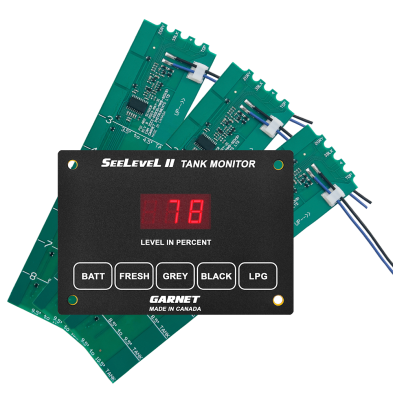Your RV’s propane system is the unsung hero of countless adventures, quietly powering hot meals, warm showers, and cozy nights on the road. At the center of it all is a small but mighty device: the RV propane gas regulator. Even though it’s easy to overlook, it handles one of the most critical safety jobs in your entire rig.
Your RV Propane System’s Silent Guardian

Think of the regulator as a pressure manager. Propane stored inside your tanks is under extremely high pressure—up to 200 PSI, a force far too powerful for your appliances to handle directly. The regulator’s job is to intercept this high-pressure flow and reduce it to a gentle, steady low-pressure supply (about 0.4 PSI) that your stove, water heater, and furnace can safely and efficiently use.
It’s this single component that ensures everything from your furnace to your cooktop gets a consistent stream of fuel to operate correctly. For any RVer, understanding its function is fundamental to safe and worry-free travels.
Quick links:
Auto-changeover two-stage regulators ·
Two-stage (single-tank) regulators ·
Marshall Excelsior ·
Camco regulators ·
Regulator covers ·
ACME pigtail hoses
Why This Little Device Is Non-Negotiable
Without a properly working regulator, the raw, intense pressure from the tank would blast through the lines and overwhelm your appliances. This would create an incredibly dangerous situation, leading to leaks, equipment damage, or even a fire.
“A properly functioning propane regulator is the cornerstone of a safe and reliable RV gas system. It single-handedly prevents over-pressurization, ensuring appliances receive the precise fuel flow they were designed for.”
Core Functions of Your RV Propane Regulator
This table breaks down the crucial jobs your RV propane regulator performs every day to keep your system safe and efficient.
| Function | Why It Matters for Your RV |
|---|---|
| Pressure Reduction | Steps down tank pressure (100–200 PSI) to appliance-safe low pressure (~0.4 PSI / 11" WC). |
| Consistent Flow | Prevents flameouts/sputtering; keeps burners blue and steady. |
| Safety Barrier | Primary protection against dangerous over-pressurization. |
| Dual-Tank Management | Auto-changeover models switch tanks automatically for uninterrupted supply. |
Decoding the Different Types of RV Regulators
The big split is single-stage vs two-stage. Single-stage drops pressure in one step; two-stage does it in two steps for steadier output—what most modern RVs use.
The Superiority of Two-Stage Regulators
- First Stage: Reduces tank pressure to ~10–15 PSI.
- Second Stage: Regulates to the final 11" WC (~0.4 PSI) your appliances expect.
Result: stable performance in cold temps and as tanks empty. Start here:
Two-stage regulators.
The Convenience of Automatic Changeover Regulators
Dual-tank setups should use auto-changeover two-stage models—continuous service, clear red/green indicator. Shop:
Auto-changeover regulators.
High-Pressure vs Low-Pressure
- Low-pressure (11" WC): Main RV system; use two-stage/auto-changeover.
- High-pressure: For external high-output appliances; not for your RV’s interior gas line.
How to Select the Perfect Regulator for Your Rig
Match three things: BTU capacity, pressure (11" WC), and fittings.
Calculate Your RV’s Total BTU Demand
Add up the BTU/hr of furnace, water heater, fridge (LP mode), stove/oven. Typical rigs land under the common regulator ratings.
- Most RV two-stage regulators: 160k–200k BTU/hr—ample for standard layouts.
Browse by brand/capacity:
Marshall Excelsior ·
Camco
Match Pressure Ratings and Connection Types
Output: 11" WC. Inlet: ACME Type 1 via pigtails. Outlet: typically 3/8" FPT.
Parts you’ll likely need on install day:
ACME pigtail hoses ·
regulator cover ·
LP thread sealant ·
leak detector
RV Regulator Type Comparison
| Regulator Type | Best For | Key Feature | Typical Application |
|---|---|---|---|
| Standard Two-Stage | Single-tank setups | Stable 11" WC output | Small/medium trailers |
| Auto-Changeover Two-Stage | Dual-tank setups | Automatic tank switch | Most travel trailers/5th wheels |
| High-Pressure | External high-BTU devices | Delivers higher pressure | Grills, fryers (external only) |
Recognizing the Warning Signs of a Failing Regulator

- Yellow/orange flames, soot
- Sputtering/popping at ignition or shutdown
- Won’t stay lit (furnace/water heater)
- Propane odor near tanks/regulator
- Heavy frost on regulator body; persistent hiss with appliances off
A Step-by-Step Guide to Replacing Your Regulator

Step 1: Prep & Tools
Shut off all appliances. Close tank valves. Gather two wrenches, new regulator, LP thread sealant, and soapy leak detector.
Step 2: Remove Old Regulator
Disconnect pigtails (ACME). Counter-hold the outlet fitting when loosening the main gas line to avoid twisting the RV pipe.
Step 3: Install New Regulator
Seal threaded joints. Hand-start fittings; snug with counter-hold. Reconnect pigtails. Mount bracket. Add a regulator cover to protect the vent (face vent down).
Step 4: Leak Test (Critical)
- Open one tank slowly (prevents pigtail excess-flow trip).
- Spray all touched joints. No bubbles = good. Bubbles = close valve, retighten, re-test.
- Open second tank (dual setups). Confirm indicator action on auto-changeover.
Maintenance & Replacement Interval
- Inspect quarterly for corrosion, debris, insect nests; keep the vent clear/covered.
- Replace regulators about every 10–15 years, or immediately if leaking/damaged.
Common Questions About RV Propane Regulators
Why is my new regulator humming?
Mild hum is normal (diaphragm action). Loud buzz after a fast tank-open usually means the pigtail’s excess-flow tripped—close, wait, reopen slowly.
Can I adjust the pressure?
No. RV regulators are factory-set to ~11" WC. If pressure is suspect, replace the unit.
Is it okay if the regulator gets wet?
They’re weather-resistant, not waterproof. Keep the vent down and use a cover.
Ready to upgrade? Find what fits your setup:
Auto-changeover two-stage ·
Two-stage (single-tank) ·
Marshall Excelsior ·
Camco ·
ACME pigtails ·
thread sealant ·
leak detector ·
regulator covers.











